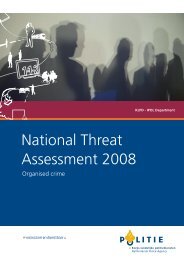Assessing the Effectiveness of Organized Crime Control Strategies ...
Assessing the Effectiveness of Organized Crime Control Strategies ...
Assessing the Effectiveness of Organized Crime Control Strategies ...
You also want an ePaper? Increase the reach of your titles
YUMPU automatically turns print PDFs into web optimized ePapers that Google loves.
lue ribbon panel funded by Congress to examine police eavesdropping, stated that even though<br />
surveillance “has resulted in <strong>the</strong> conviction <strong>of</strong> a very small number <strong>of</strong> upper echelon organized<br />
crime figures” it was “generally unproductive” in terms <strong>of</strong> cost, manpower, and convictions<br />
(Albanese, 1996:178).<br />
Many significant convictions achieved with <strong>the</strong> help <strong>of</strong> surveillance since that assessment in <strong>the</strong><br />
1970s, such as that <strong>of</strong> Gambino family boss John Gotti on racketeering and murder charges,<br />
might change that conclusion. Also, <strong>the</strong> experience in <strong>the</strong> State <strong>of</strong> New Jersey is worth<br />
considering. In 1969, <strong>the</strong> state’s legislature authorized electronic surveillance following<br />
revelations that mobsters had infiltrated <strong>the</strong> highest reaches <strong>of</strong> government and industry in <strong>the</strong><br />
state (Krajick, 1983:31). A massive campaign <strong>of</strong> surveillance ensued for several years. The<br />
result was not only <strong>the</strong> incarceration <strong>of</strong> dozens <strong>of</strong> OC figures but <strong>the</strong> departure from <strong>the</strong> state <strong>of</strong><br />
40-50 high-level <strong>of</strong>fenders. What is unknown is whe<strong>the</strong>r <strong>the</strong> incarcerated and <strong>the</strong> departed<br />
reconstituted <strong>the</strong>ir illicit networks at a later point or merely relocated <strong>the</strong>ir activities.<br />
Albanese (1996:178) notes that what is needed is an assessment <strong>of</strong> <strong>the</strong> cost-benefit <strong>of</strong> electronic<br />
surveillance as opposed to o<strong>the</strong>r investigative tools. He fur<strong>the</strong>r notes that research is required to<br />
identify <strong>the</strong> types <strong>of</strong> cases, locations, and suspects in relation to whom it is most cost effective, as<br />
well as <strong>the</strong> investigative tools with which it works best.<br />
In Canada, Part XI <strong>of</strong> <strong>the</strong> Criminal Code acknowledges <strong>the</strong> necessary use <strong>of</strong> lawful information<br />
intercepts in combating OC. However, this review did not uncover any assessments <strong>of</strong> <strong>the</strong> use or<br />
impact <strong>of</strong> such intercepts.<br />
4.15 Intelligence Analysis<br />
Intelligence involves <strong>the</strong> collection, evaluation, and interpretation <strong>of</strong> information. The aim <strong>of</strong><br />
intelligence work is to increase understanding about an issue, as well as to assist in preventive<br />
efforts and policy development (Abadinsky, 2003: 341). Tactical intelligence serves <strong>the</strong> more<br />
immediate law enforcement objectives <strong>of</strong> arrest and prosecution, while strategic intelligence<br />
serves more long range aims (e.g., understanding new patterns <strong>of</strong> OC activity and <strong>the</strong> threats <strong>the</strong>y<br />
pose).<br />
The sources <strong>of</strong> intelligence data are varied: court data, business and financial records,<br />
newspapers and o<strong>the</strong>r publications, physical and electronic surveillance, and statements or<br />
testimony by informants, victims, accomplices, and law enforcement personnel (Abadinsky,<br />
2003: 342; Peterson, 1994). The analysis <strong>of</strong> intelligence data is similar to hypo<strong>the</strong>sis testing in<br />
science, whereby an analyst systematically weighs <strong>the</strong> evidence in support <strong>of</strong> a given belief (e.g.,<br />
OC has infiltrated a given industry in a certain city). If <strong>the</strong> hypo<strong>the</strong>sis or belief withstands<br />
rigorous testing, it becomes <strong>the</strong> basis for an intelligence report.<br />
Sound FBI intelligence work, for example, laid <strong>the</strong> groundwork for <strong>the</strong> successful prosecution <strong>of</strong><br />
many members <strong>of</strong> New York City’s five Cosa Nostra families. Separate teams <strong>of</strong> FBI agents<br />
were responsible for describing each family’s organizational structure—identifying all members<br />
and <strong>the</strong>ir status within <strong>the</strong> organization—and determining <strong>the</strong> industries and rackets in which <strong>the</strong><br />
family was involved (Jacobs and Gouldin, 1999: 163). After documenting <strong>the</strong> family’s<br />
Research and Statistics Division / Department <strong>of</strong> Justice Canada | 47








